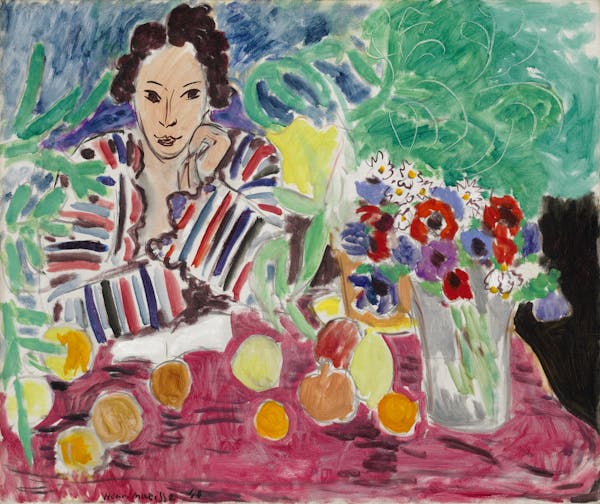Art is no longer enough for most art museums to succeed.
While big exhibits still drive attendance, as the "Matisse" show is expected to do when it opens Sunday at the Minneapolis Institute of Arts, a marquee name doesn't guarantee what the new breed of museum marketers calls "brand loyalty."
Like many U.S. museums, the MIA is aiming to be a year-round destination for all kinds of people rather than a hot spot just for the culturati. That requires fine-tuning everything from its food service to its lounge chairs, and adding events such as Bike Night, when hundreds of young cyclists roll into the museum's courtyard.
"It's important that people experience the museum as they want, not as we see them," said Kristin Prestegaard, the MIA's chief engagement officer.
"Engagement" is a buzzword at museums across the country. The Dallas Museum of Art stays open until midnight once a month with free films, DJs, poetry slams and even yoga for kids. The restaurant at Atlanta's High Museum of Art is so popular it's open more hours than the museum. Already renowned for its film center, Oregon's Portland Art Museum is now touting its rentable event spaces, including two wedding-perfect ballrooms.
In Minneapolis, attendance at the American Swedish Institute doubled last year following the 2012 opening of a new wing with the popular Fika restaurant and the addition of "Cocktails at the Castle" and other events aimed at a young crowd. Walker Art Center moves outdoors in the summertime to roll out artist-designed mini-golf in the Minneapolis Sculpture Garden and such populist events as Rock the Garden and the Internet Cat Video Festival.
Now the MIA is stepping up its game, too.
"We spent the last 20 years expanding — growing the building and the endowment," said museum director Kaywin Feldman. "This period is about expanding inside the building. It's about the magic. This is our moment to really inflame the opportunities here."
Bring in the chairs
Exhibitions and the museum's collection remain the heart of what goes on at 2400 3rd Av. S., but chairs are important, too. And coffee. That's why curvy ivory-plastic chairs and little tables now cluster on a new purple rug in the entrance lobby, and the scent of Dogwood's specialty coffees wafts from a new cafe.
"They live and breathe artisanal roasting the way we live and breathe Matisse," said Hunter Wright, the MIA's venture innovation director, who joined the staff last year after more than a decade at New York art institutions, including the Museum of Modern Art.
She and a cross-departmental team are working out new signage for the lobby, testing fresh lighting, and even mulling about sounds and scents. There will be music in the redesigned gift shop, coffee prep sounds from the cafe, information via video projections, and chatter from Half Pint, a new cafe aimed at kids.
A lounge area will have shelves of art books and magazines. Visitors can tap into high-speed Wi-Fi. The gift shop will offer more "destination retail," such as original jewelry by a contemporary Kenyan designer rather than just replicas of the museum's collection. Dogwood and its partners also have taken over the upstairs restaurant, renaming it Grain Stack and featuring locally sourced food and beverages.
"We want to offer more reasons for more people to come here more often," said Wright. That means "raising the level of amenities to present a seamless experience that matches the level of the art."
Contemporary music is on the menu, too, with a "Sound.Art.MIA" series that launches Thursday with a concert featuring Kim Gordon of art-rock pioneers Sonic Youth — an artist who might seem more at home at the avant-leaning Walker.
Retooling exhibitions
Last year, the exhibits "Rembrandt" and "Terra Cotta Warriors" helped entice a record 680,000 people to the museum, a number that staff know they probably won't equal this year. Still, they're aiming for 100,000 visitors to "Matisse" and hope to match that with "Italian Style: Fashion Since 1945," the museum's first-ever fashion exhibit, opening in October. Gold and bejeweled bling arrive from Vienna next February with "Empire: Treasures From the Hapsburgs."
Hoping to sustain that momentum, the museum is rethinking its exhibition strategies. Economics drive many of the changes. Except in rare cases, the blockbuster shows that individual museums started doing in the 1960s are no longer financially sound.
Now museums spread the costs by sharing responsibilities. While one institution oversees catalog preparation, another may line up national sponsors and a third will negotiate a federal insurance guarantee. The Matisse exhibit has already been shown in Indianapolis and Houston, and "Empire" is a collaboration with museums in Vienna, Atlanta and Houston.
"If we're not able to get partners, we can't proceed because the return on investment is just not there," said Matthew Welch, the MIA's deputy director and chief curator.
Concepts are also scrutinized closely. "Certain names we know will always do well — Rembrandt and Matisse will do very well; Picasso will do great," Welch said. "At the same time, we will always do exhibitions that should be done, that are scholarly and important.
"The end game in all this is to develop a public that says, 'Oh, I've never heard of Artist X, but I don't care because everything the MIA does is spectacular.' "
Mary Abbe • 612-673-4431

Minnesota Sports Hall of Fame: A class-by-class list of all members

This retired journalist changed professional wrestling from Mankato

